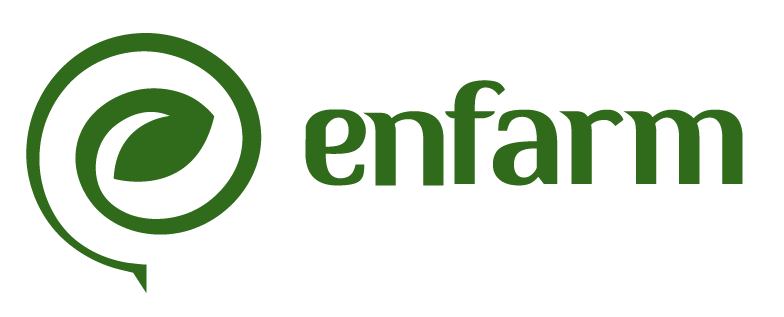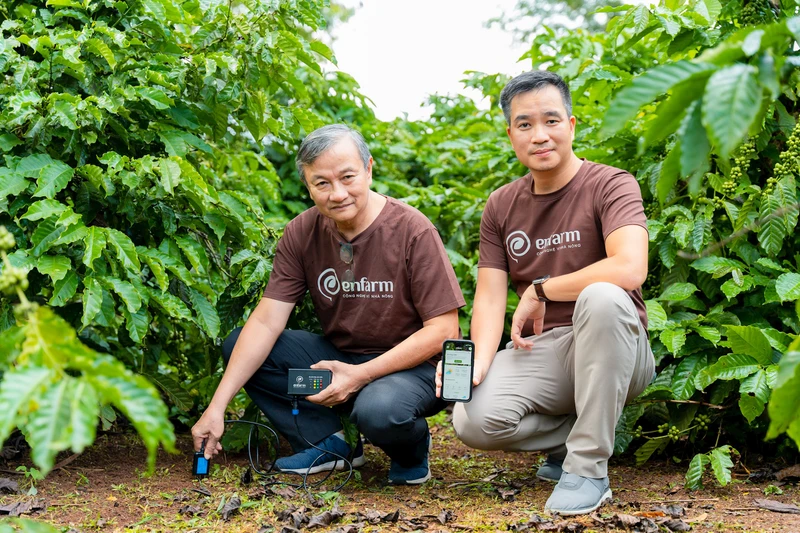News
Enfarm and Farmers Working Toward Sustainable Agriculture
With its two cofounders, CEO Do Dung Nguyen and Chief Technology Officer Long Phi Ho, Enfarm Agritech’s technology empowers hardworking farmers to become knowledgeable agricultural experts who understand their land and keep up with market trends. They firmly believe that smart fertilization and connecting smallholder farmers to markets are among the most crucial solutions for increasing the income of tens of millions of farmers and ensuring green, sustainable agricultural development.

WORKING WITH FARMERS TOWARD SUSTAINABLE AGRICULTURE
With cofounders CEO Do Dung Nguyen and Chief Technology Officer Long Phi Ho, Enfarm Agritech believes that their technology helps hardworking farmers become knowledgeable agricultural experts who understand their soil and keep up with market trends. They are firmly convinced that smart fertilization and connecting smallholder farmers to markets are two of the most important solutions to improve incomes for tens of millions of farmers and to ensure a green, sustainable future for agriculture.
The consequences of improper fertilization
“Did you know that 30 to 40 percent of agricultural production costs go to fertilizer, while 60 percent of it is wasted due to incorrect application? The vicious cycle between fertilizer misuse and soil degradation eats away at household income and damages the environment. Fertilizer alone accounts for up to 5 percent of total global greenhouse gas emissions, more than the combined emissions from air and sea transport.”
With that concern, Do Dung Nguyen began the conversation about the smart fertilization technology — Enfarm Agritech’s flagship innovation — with a heavy sense of urgency.
In his eyes, farmers often stand alone. Relying mostly on experience, they receive little support from scientific data. They face climate and weather risks daily and are constantly worried about market volatility. A bumper crop often leads to price drops, while high prices frequently come during low harvests. Yet their average income remains very low, around 3.6 million VND per month. In Vietnam’s coffee sector, despite being the second-largest exporter globally — and the largest when it comes to robusta — farmers only earn about 2 percent of the retail value of a cup of coffee. They remain the most vulnerable and least rewarded actors in the agricultural value chain.
For Dr. Long Phi Ho, a respected expert in water resources and climate change, solving the fertilizer problem also means contributing to greenhouse gas reduction. Nitrogen fertilizer production consumes a lot of energy, and unused fertilizer releases nitrous oxide, a gas with 300 times the heat-trapping potential of carbon dioxide. The estimated 6.6 million tons of surplus fertilizer annually has caused widespread soil acidification, forcing farmers to use even more fertilizer, increasing their costs while worsening the problem.
Fertilizer prices have tripled over the past three years. At current rates, the annual loss from fertilizer waste could reach 3.6 billion USD. Moreover, fertilizer runoff during rainfall seeps into groundwater, polluting water sources. It is truly a double blow to both farmers and the environment.
Diagnosing the problem and prescribing the right solution
Worried about the heavy burden carried by farmers and the environment, Enfarm Agritech set out to develop a smart fertilization solution using Internet of Things (IoT) and Artificial Intelligence (AI). The Enfarm F device (a handheld device for farms of all sizes) and Enfarm F+ (an automated device for farms of 10 hectares or more) consist of two components: a sensor that collects growth and soil data, and a logger that transmits it to Enfarm’s server. The AI system then analyzes the data and provides tailored recommendations to users through a smartphone app.
Enfarm’s AI evaluates four interconnected factors — soil, water, crops, and fertilizer — to provide customized recommendations such as when to fertilize, what type to use, how much, and how much water is needed.
There is never a one-size-fits-all formula for every field. Nutrient conditions depend on numerous variables such as irrigation volume, soil’s water retention and nutrient-holding capacity, and the crop’s needs and absorption ability. This is why Enfarm’s system becomes a true agricultural companion, offering 24/7 support tailored to each specific situation.
As the only technology tested and calibrated to Vietnamese soils and specific crops like coffee, durian, and dragon fruit, Enfarm is also the only platform that advises farmers in Vietnamese. In addition, the app offers features that help increase farmers’ income, such as boosting yields by up to 20 percent with the same or less fertilizer, reducing fertilizer use by up to 50 percent, diagnosing plant diseases with AI, and forecasting market prices.

With a clear advantage in pricing and ease of use compared to similar products such as Teralytic’s sensor system from the US which starts at over 3,000 USD, this technology is well suited to the agricultural conditions of developing countries with small and medium scale production.
At a rental cost of just around 5.1 million VND (approximately 200 USD) per hectare per year, the Enfarm device continuously monitors seven key soil indicators (NPK nutrients, moisture, pH, electrical conductivity, and temperature) via a sensor buried 30 cm underground. This sensor transmits real-time data every 15 minutes to a central server located in Ho Chi Minh City, which processes the data and generates timely, scientific, and effective recommendations.
According to the Tay Nguyen Institute for Agricultural Science and Technology (WASI), the Enfarm system achieves laboratory-level accuracy: 90 percent for nitrogen and potassium, 70 percent for phosphorus, and 99 percent for soil moisture.
Thanks to real-time alerts notifying that the optimal level of fertilizer had been reached, Mr. Phan Minh Tinh from Eatu Commune, Buon Ma Thuot City, decided to stop fertilizing and saved 3 million VND in costs while his coffee trees continued to grow healthily. Meanwhile, Mr. Doan, Production Director of the Helena Chu K’Bo Fair and Sustainable Agricultural Cooperative, which manages 450 hectares of robusta coffee, said: “The technology has proven highly effective, reducing fertilization costs while increasing crop yields.”
Increasing economic value for agricultural products
In September 2023, Enfarm began pilot deployments at two cooperatives and ten farming households covering nearly 1,000 hectares of coffee plantations in Dak Lak. Official product sales began in February 2024. As of now, over 500 sensors have been installed. This smart nutrient monitoring technology has led to a 20 percent increase in yields without increasing input costs. With green coffee beans priced at a steady 120 million VND per ton and an average yield of 3.5 tons per hectare, the 20 percent yield increase has brought farmers a substantial income boost of more than 80 million VND per year.
In 2024, Enfarm Agritech aims to expand and finalize the application of this technology for several other crops such as durian, jackfruit, and avocado, while also extending its reach to the Mekong Delta. Support from the government and collaboration with like-minded organizations is what the Enfarm team is striving for to advance green, clean, and sustainable agriculture.
Nhìn xa hơn, đội ngũ enfarm kỳ vọng vào việc gia tăng giá trị kinh tế cho nông sản, giúp nông dân có thể làm giàu từ đôi bàn tay cần cù chăm chỉ. Nếu bà con cắt giảm lượng phân hóa học, nếu thiết bị cảm biến chứng minh được vị trí trồng cà-phê không có nguồn gốc đất từ hoạt động phá rừng bằng một mã vùng trồng, cà-phê Việt sẽ được cộng thêm điểm, được thu mua với giá cao hơn bởi các nhà nhập khẩu cũng như xuất khẩu nông sản từ châu Âu. Thêm nữa, nhờ nắm chắc hai đại lượng carbon đầu vào (phân bón) và đầu ra (số cây trồng hấp thụ), nguồn lợi tín chỉ carbon thu được sẽ giúp cà-phê bán được giá tốt hơn, nhờ phương thức canh tác thân thiện với môi trường.
Trong tương lai, vị CEO nhiệt huyết với nông nghiệp xanh, bền vững này còn theo đuổi giấc mơ chuẩn hóa nông sản với sự công nhận của các tổ chức quốc tế uy tín, khi những sản phẩm đóng dấu enfarm có thể truy xuất toàn bộ quy trình trồng trọt. Người nông dân sẽ có thể nâng cao giá trị cho sản phẩm của mình, thay vì ngậm ngùi nhận lợi ích thấp nhất nhưng phải gánh chịu rủi ro cao nhất – như bây giờ.The Enfarm team envisions increasing the economic value of agricultural products and helping farmers prosper through hard work. If farmers reduce chemical fertilizer use, and if the sensor device can verify that the coffee growing location is not on deforested land using a certified planting zone code, Vietnamese coffee will earn bonus points and command higher prices from European importers and exporters.
Moreover, by accurately measuring both carbon inputs (fertilizer use) and outputs (plant absorption), carbon credit gains will help improve the selling price of coffee grown using environmentally friendly practices.
In the future, the dedicated CEO of Enfarm continues to pursue the dream of standardizing agricultural products with recognition from reputable international organizations. Enfarm-labeled products will be fully traceable throughout the entire cultivation process. Farmers will be empowered to increase the value of their produce, instead of being stuck with the lowest profits and highest risks — as is the case today.



